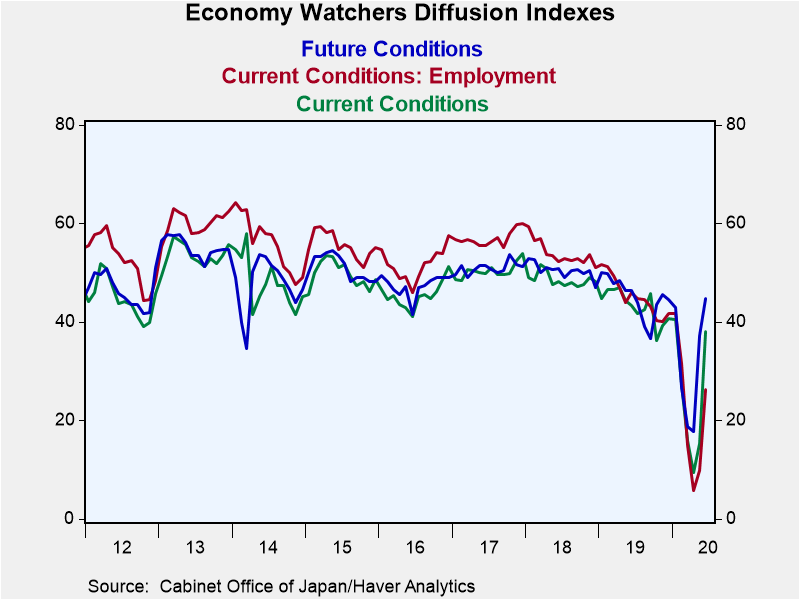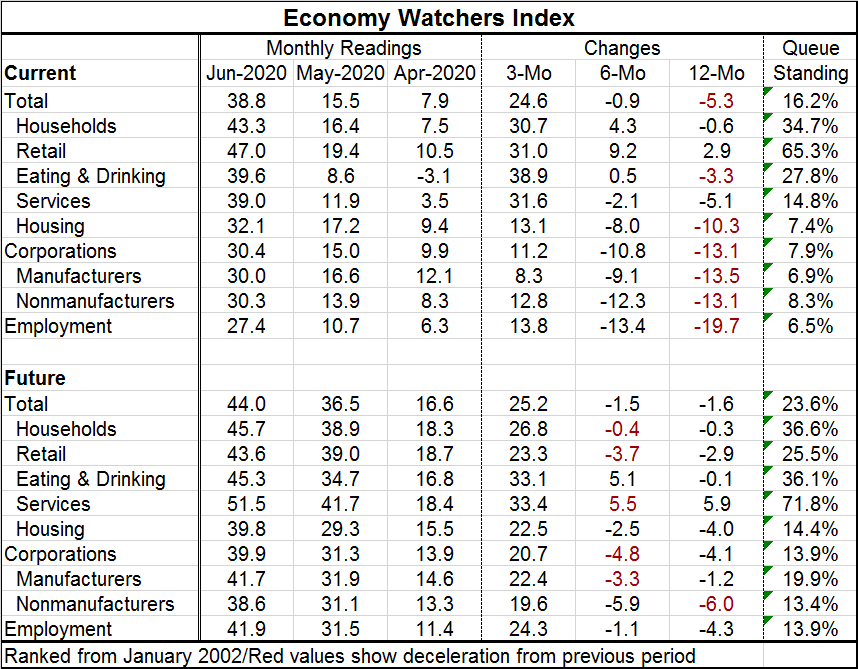 Global| Jul 08 2020
Global| Jul 08 2020Japan's Economy Watchers Index Rebounds
Summary
Japan's economy watchers current index jumped to 38.8 in June from 15.5 in May. The index had largely been in a range from 37 to 47 from August 2019 to January 2002. It then slipped to 27.4 in February and again to 14.2 in March and [...]
 Japan's economy watchers current index jumped to 38.8 in June from 15.5 in May. The index had largely been in a range from 37 to 47 from August 2019 to January 2002. It then slipped to 27.4 in February and again to 14.2 in March and finally to its cycle low at 7.9 in April as the virus took its toll. From there the index has been rebounding. It is now in the bottom portion of its previous range for late-2019.
Japan's economy watchers current index jumped to 38.8 in June from 15.5 in May. The index had largely been in a range from 37 to 47 from August 2019 to January 2002. It then slipped to 27.4 in February and again to 14.2 in March and finally to its cycle low at 7.9 in April as the virus took its toll. From there the index has been rebounding. It is now in the bottom portion of its previous range for late-2019.
Even so, this is a weak reading. It has only a 16.2 percentile standing, leaving it very low in its queue of historic data. Japan's economy had not been firing on all cylinders when the virus crisis struck. So its return to the bottom of its previous range still leaves Japan's activity adversely impacted.
Manufacturing and nonmanufacturing businesses alike show very weak readings for June. The employment reading is also extremely weak. However, in the services sector, retailing is showing a 65.3 percentile standing, the only current economy watchers reading above its historic median. Still, this report has to be regarded as exceptionally weak even with the month's strong rebound.
The economy watchers future index has its largest move in May, rising to 36.5 from April's 16.6. It rose again in June, gaining to 44.0 from 36.5. Its rank-standing, however, is still weak at its 23.6 percentile. Like the current index at a level of 44, the future index is back in the range it had occupied in the latter part of 2019.
Both the current and the future economy watchers indexes are lower on balance over 12 months. Both rank at very low points in their respective historic queues of data. Both have extremely weak readings in place for manufacturing and nonmanufacturing businesses as well as a weak employment reading.
The future index had it strongest reading in June for services. That sector standing is in its 71.8 percentile, a respectable level of moderate strength. Yet, it is the only sector standing above its historic median as of June. The next strongest future readings are for eating & drinking places and for the household sector with rankings in their respective 36th percentiles above those for other components but still extremely low - barely out of the lower one-third of their historic queue of observations.
Although the economy watchers survey shows a solid rebound in June, it does not depict a strong or vibrant economy. The readings are still lackluster and it is still hard to get a sense of the momentum that may be in play. Japan's economy still appears to be struggling. The economy watchers assessments are still uniformly weak.

Robert Brusca
AuthorMore in Author Profile »Robert A. Brusca is Chief Economist of Fact and Opinion Economics, a consulting firm he founded in Manhattan. He has been an economist on Wall Street for over 25 years. He has visited central banking and large institutional clients in over 30 countries in his career as an economist. Mr. Brusca was a Divisional Research Chief at the Federal Reserve Bank of NY (Chief of the International Financial markets Division), a Fed Watcher at Irving Trust and Chief Economist at Nikko Securities International. He is widely quoted and appears in various media. Mr. Brusca holds an MA and Ph.D. in economics from Michigan State University and a BA in Economics from the University of Michigan. His research pursues his strong interests in non aligned policy economics as well as international economics. FAO Economics’ research targets investors to assist them in making better investment decisions in stocks, bonds and in a variety of international assets. The company does not manage money and has no conflicts in giving economic advice.






